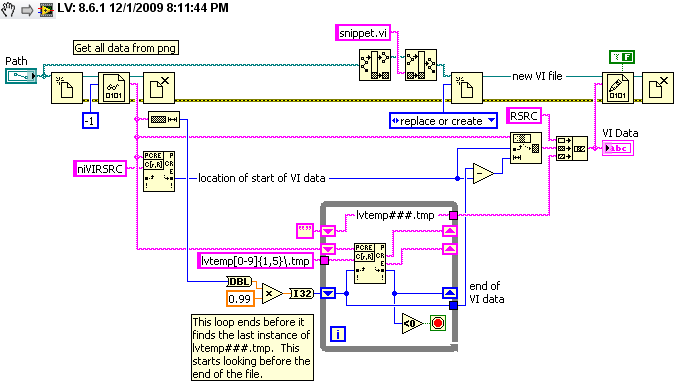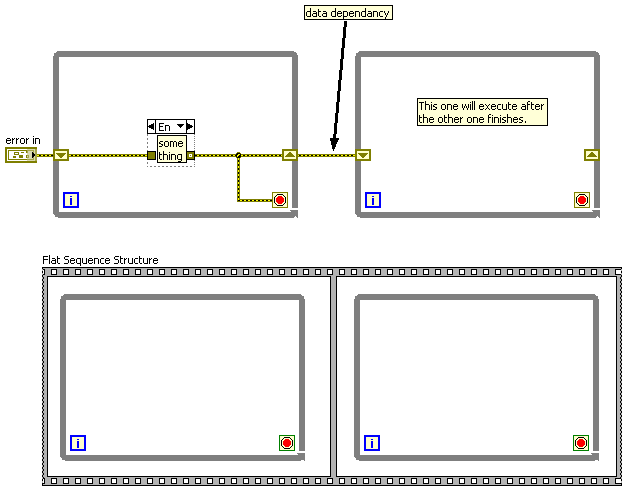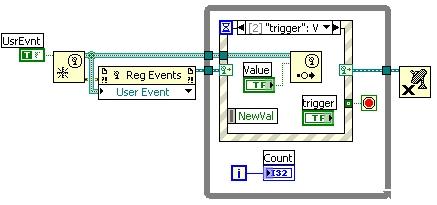-
Posts
951 -
Joined
-
Last visited
-
Days Won
39
Content Type
Profiles
Forums
Downloads
Gallery
Posts posted by jcarmody
-
-
Shouldn't be too hard (yours to try), but the code is embedded inside a PNG tag as a saved VI, just open up and dump like a merge VI.
Here's a LabVIEW 8.6 VI that takes a path to a snippet-embedded PNG file and creates a snippet.vi in the same folder. I'm not happy with the way I did it; it works, but I have a feeling that there's a more elegant method. The next thing I'd like to try is to make a JKI RCF plugin that converts a PNG on the BD into code. It would be nicer to be able to have LabVIEW respond to a PNG being dropped onto the BD; do you know how I might do that?
Hey folks! This picture is a Snippet made with the Code Capture Tool in LV 8.6!

-
[...] I definitely think you should seriously consider using TestStand.
I purchased a Debug Deployment license for my project. I will use it, but my TestStand skills today are worse than my LabVIEW skills were two years ago.



Firstly, there's a difference between a state machine and a sequence machine.
Please help me better understand the distinction. I use macros for sequencing tests and operations that make up a test, but the sequences can branch depending upon how the UUT responds. I call it a State Machine...
-
TestStand

So, instead of having a large State Machine I'll have a large list of subsequences? That's feels better but I can't explain why.
I think I'll use it, but it'll be for the built-in reporting and data storage and not because it's more readable. What else will I gain that addresses the issues folks have with my old kind of State Machine?
-
I'm intrigued by a few discussions we've had recently and am here to ask what architecture y'all use when writing a program to implement a long test procedure. Here's the first discussion, and here's the second.
Here's the scenario:
I have two test procedures for a product I need to test: an MTP (Manufacturing Test Procedure) and ATP (Acceptance Test Procedure). Each procedure contains a dozen or more individual tests (some are common between the two), each test requires configuring and reading a few IO devices and the application must have a reasonably functional user interface that allows automatic testing as well as permit a Technician to debug the UUT. My approach has been to write a JKI State Machine with states to control the hardware and macros to sequence the tests; this results in a long list of states. Several respectable LAVA contributors in the aforementioned discussions eschew this design, so my question is: what architecture can perform all my tests without using the kind of State Machine I've described?
-
NR-AWOL is more like it! I stopped giving my money to these gun-control traitors long ago. I keep getting the magazine, though, I'm a Life Member!

-
never mind...
-
The Code Capture Tool rocks.
 I love it.
I love it.  . The video was a great touch, too.
. The video was a great touch, too.Just to be clear (because I can't test it) folks will be able to drag a snippet made with the CCT in LV 8.6 to a LV 2009 BD? I'm wondering when CCT 3.0 will come out, with the ability to extract the code from a snippet in pre-2009 versions...

-
[...]However if you don't use any of his techniques the while loops will run in parallel.
But, one of them will start first. No? And which one does is indeterminate and unreliable. If you have a producer and a consumer loop, and the consumer is set to stop when the queue it's consuming is empty, you want to make sure the producer starts first. That's what I was going for. If it happens to start in the proper order in development (giving you a false sense of confidence in your code) you won't be able to count on it working as an executable or on another target. I think.
See attached example.
I have an alternative to your forth example.
 (Don't look under the hood, it has a sequence structure.)
(Don't look under the hood, it has a sequence structure.).png)
-
[...] If I drop two independent while loops into a VI, independent in the sense that neither while loop requires any information from the other to proceed to some conclusion, in what order will they execute? How can I control this order?
1) They'll execute when all of their inputs are satisfied; if nothing forces one to start first then it's up to the Operating System to decide. Although I believe the winner is (practically) arbitrary and you can't depend on the order. You're better off forcing an order if it's important to you.
2) If you want to force one of them to run after the other you need to force a data dependency between the two of them, or you can throw style to the wind
 and use a Sequence Structure
and use a Sequence Structure  .
.One advantage to the first option is that the error cluster is passed throughout the program. You are passing your error cluster throughout your program, right?
-
[...]Well this starts to snowball into a bigger issue when someone decides that they just don't want to execute that one event state, but rather I need 4 states executed and I want that state to always be the second of the 4. What typically happens, is that the end user just starts stringing together multiple Val(signaling) properties for multiple controls to call multiple event states. This is particularly bad because there is no guarantee that as you string together Val(signaling) properties that they'll execute in that order, so you've just introduced potential bad logic in your vi.
I did not know that. Thanks.
-
[...]Please keep your recommendations based in science and provable facts.
Here's an article related to your condition, but it's not going to recommend a drug or medical procedure in the end. The article refers to many scientific works from such "reputable" sources as Circulation (AMA), The Journal of the American College of Cardiology, The American Journal of Medicine and the Journal of the American Medical Association.
Remember that GIGO applies to our bodies as well as it does to the programs we write. I'm not sure how you'll feel about this, but it's worth mentioning because the world needs all the LabVIEW Architects it can get. Good luck.

Three quotes for those TL/DR-type readers:
Although angioplasty has been performed for nearly 3 decades and over one million procedures are done annually, you should be astonished to learn this fact: Angioplasty has never been shown to save the lives of patients who are treated for chronic heart blockages.3,4The only indication for angioplasty is to relieve incapacitating chest pain—since this surgery has not been shown to save lives.3,4,7,9,13,14 To use the promise of prolonging lives as the sales pitch is dishonest.I have studied heart disease for the past 35 years, and everything I know about angioplasties and bypass surgery makes me want to stay clear of these businesses unless there is absolutely no other alternative. The real alternative that too few people take advantage of is prevention: A low-fat, plant-food based diet, exercise, and clean habits will prevent this disease. Once the disease has started it can be stopped and in most cases reversed with this lifestyle medicine.18 -
That did it for both LV versions. Thanks.
-
[...]And also can you give me some more info about the other methods you propose?
The first thought I had when reading your original post was to use a User Event. These are events similar to Front Panel object events, but you determine the data type and you write code to trigger them wherever you want. In your case, you'd trigger it when you get the xFF from the microcontroller and your Event Structure will respond.
Here's an example.
-
 1
1
-
-
I just tried Install Code Capture Tool.vi on 8.2 without success. I've attached a screen capture of the result. A small window flashes after a slight pause, before the error message comes up. Perhaps that's a clue to what's happening?
I tried the version you sent privately, but it didn't change anything. Perhaps I'll wait a few days to see if other folks with XP have the same trouble I'm having. I'd hate to have you spend time fixing something that isn't broken on your end.
Thanks.
-
what OS are you on?
Do you have read/write privileges on your LabVIEW data folder? Especially the Code Capture Tool.ini file?
Windows XP
Yes
-
I tried to install this from VIPM without success. VIPM couldn't install it for LV 8.2; 8.6 completed successfully but I got an "Error 7 occurred at Open Config Data.vi" in 8.6. I went back and ran Install Code Capture Tool.vi in 8.6 and got the same error.
Without CCT, I'll have to resort to taking pictures of my monitor to attach to my posts.

-
Nine people of my size will be the first ton.You know you're gonna make tons of happy people.

-
Stop.There has been some discussion about managing a large number of states in a state machine neatly.
Jim Carmody came up with this brilliant solution.
 You're embarrassing me... [...] If a group of states (e.g. UI) gets too large, I will move all UI states to their own case (owned by the separator case).
You're embarrassing me... [...] If a group of states (e.g. UI) gets too large, I will move all UI states to their own case (owned by the separator case).This seems to be neater and easy to read then having to scroll the state drop down menu when the number of states starts getting large.
I addressed this issue (to my satisfaction) in the CaseSelect RCF plugin by using a tree with collapsible branches. The context menu lets you collapse or expand them all at once so you don't need to scroll past a long list.
I like the work you did, however I almost got my feelings hurt in another thread that suggested *gasp* that a State Machine should never have as many states as I use. One thing I got out of that discussion got me thinking of my habit of using macros. I make a macro to perform a complicated function, but the steps of that function are all exposed as well. It's not so much trouble for me to maintain the software, but someone else after me may not recognize the utility of the macro and either miss some necessary steps or waste time redeveloping it. I'm thinking that I need to use sub-VIs rather than more sections in my State Machine. (Encapsulation?)
Jim
-
You could check the MD5 checksum of the executable and compare it with the latest file on your network. Your application would only need to know the path to the latest-and-greatest version and could compare the two.
-
How to upload many pictures
The same way you eat an elephant, one byte at a time.

-
Your post has been read a bunch of times without being answered. I can't understand what you're asking; perhaps you should restate the question.
-
[...] attach an accelerometer to his head and see if he's purring at 26 hertz!
The first thing I thought of when you wrote that was sharks with lasers attached to their heads...
-
You were correct to use a loop, but a For Loop isn't correct unless you know exactly how many times the substring exists in the main string. I used a While Loop with the 'offset past match' to detect when to stop (it'll be -1 if the search string isn't found). I'm not sure what you mean about storing "that substring into an array", but you can wire the 'match substring' of the Search function to an indexing tunnel and you'll get an array of the substring with as many elements as there are occurrences.
-
Do you know what substring to detect or do you need to detect a repeating substring?







[LVTN] Code Capture Tool
in End User Support
Posted
Thanks. I actually had studied the vi that embedded the snippet but took the long way around. It's much prettier now .
.
GetSnippet.vi